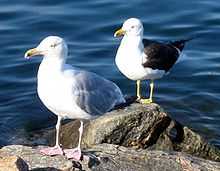Larus
| Larus | |
|---|---|
 | |
| Herring Gull | |
| Scientific classification | |
| Kingdom: | Animalia |
| Phylum: | Chordata |
| Class: | Aves |
| Order: | Charadriiformes |
| Family: | Laridae |
| Genus: | Larus Linnaeus, 1758 |
| Species | |
|
See list | |
Larus is a large genus of gulls with worldwide distribution (although by far the greatest species diversity is in the Northern Hemisphere). Many of its species are abundant and well-known birds in their ranges. Until about 2005–2007, most gulls were placed in this genus, but this arrangement is now known to be polyphyletic, leading to the resurrection of the genera Ichthyaetus, Chroicocephalus, Leucophaeus, and Hydrocoloeus (this last had been recognized more often than the other genera) for several species traditionally included in Larus.
They are in general medium to large birds, typically grey or white, often with black markings on the head or wings. They have stout, longish bills and webbed feet.
The taxonomy of the large gulls in the Herring and Lesser Black-backed complex is very complicated, different authorities recognising between two and eight species. See also Hybridisation in gulls.
Systematics and evolution
List of species
- Pacific Gull, Larus pacificus
- Belcher's Gull, Larus belcheri
- Olrog's Gull, Larus atlanticus
- Black-tailed Gull, Larus crassirostris
- Heermann's Gull, Larus heermanni
- Common Gull or Mew Gull, Larus canus
- Ring-billed Gull, Larus delawarensis
- California Gull, Larus californicus
- Great Black-backed Gull, Larus marinus
- Kelp Gull, Larus dominicanus (called "Southern Black-backed Gull" or "Karoro" in New Zealand)
- Cape Gull, Larus dominicanus vetula
- Glaucous-winged Gull, Larus glaucescens
- Western Gull, Larus occidentalis

- Yellow-footed Gull, Larus livens
- Glaucous Gull, Larus hyperboreus
- Iceland Gull, Larus glaucoides
- Kumlien's Gull, Larus glaucoides kumlieni
- Thayer's Gull, Larus thayeri
- Herring Gull, Larus argentatus
- Heuglin's Gull, Larus heuglini
- American Herring Gull, Larus smithsonianus
- Yellow-legged Gull, Larus michahellis
- Caspian Gull, Larus cachinnans
- East Siberian Gull, Larus vegae (or Vega Gull)
- Birula's Gull, Larus vegae birulai
- Armenian Gull, Larus armenicus
- Slaty-backed Gull, Larus schistisagus
- Lesser Black-backed Gull, Larus fuscus
- Saunders' Gull, Larus saundersi
Fossils of Larus gulls are known since the Middle Miocene, c.20-15 mya; allocation of earlier fossils to this genus is generally rejected nowadays (see below). Biogeography of the fossil record suggests that the genus evolved in the northern Atlantic and spread globally during the Pliocene, when species diversity seems to have been highest as with most seabirds.
- Larus sp. (Grund Middle Miocene of Austria)
- Larus sp. (Middle Miocene of Romania) (Olson, 1985)
- Larus sp. (Late? Miocene/Early Pliocene of Lee Creek Mine, USA) - several species (Olson, 1985)
- Larus elmorei (Bone Valley Early/Middle Pliocene of SE USA)
- Larus lacus (Pinecrest Late Pliocene of SE USA)
- Larus perpetuus (Pinecrest Late Pliocene of SE USA)
- Larus sp. (San Diego Late Pliocene of SW USA)
- Larus oregonus (Late Pliocene - Late Pleistocene of WC USA)
- Larus robustus (Late Pliocene - Late Pleistocene of WC USA)
- Larus sp. (Lake Manix Late Pleistocene of W USA)
"Larus" raemdonckii (Early Oligocene of Belgium) is now at least tentatively believed to belong in the procellariiform genus Puffinus. "L." elegans (Late Oligocene?/Early Miocene of St-Gérand-le-Puy, France) and "L." totanoides (Late Oligocene?/Early Miocene of SE France) are now in Laricola, while "L." dolnicensis (Early Miocene of Czechia) was actually a pratincole; it is now placed in Mioglareola.
The Early Miocene "Larus" desnoyersii (SE France) and "L." pristinus (John Day Formation, Willow Creek, USA) probably do not belong in this genus; the former may be a skua (Olson, 1985).
Ring species

(1 : Larus argentatus argentatus, 2: Larus fuscus sensu stricto, 3 : Larus fuscus heuglini, 4 : Larus argentatus birulai, 5 : Larus argentatus vegae, 6 : Larus argentatus smithsonianus, 7 : Larus argentatus argenteus)
The circumpolar group of Larus gull species has often been cited as a classic example of the ring species. The range of these gulls forms a ring around the North Pole. The Herring Gull, which lives primarily in Great Britain, can hybridize with the American Herring Gull (living in North America), which can also interbreed with the Vega or East Siberian Herring Gull, the western subspecies of which, Birula's Gull, can hybridize with Heuglin's gull, which in turn can interbreed with the Siberian Lesser Black-backed Gull (all four of these live across the north of Siberia). The last is the eastern representative of the Lesser Black-backed Gulls back in northwestern Europe, including Great Britain. However, the Lesser Black-backed Gulls and Herring Gull are sufficiently different that they cannot interbreed; thus the group of gulls forms a continuum except in Europe where the two lineages meet. However, a recent genetic study has shown that this example is far more complicated than presented here, and probably does not constitute a true ring species (Liebers et al., 2004).
References
- Harrison, Peter (1988): Seabirds (2nd ed.). Christopher Helm, London ISBN 0-7470-1410-8
- Liebers, Dorit; de Knijff, Peter & Helbig, Andreas J. (2004): The herring gull complex is not a ring species. Proc. Roy. Soc. B 271(1542): 893-901. doi:10.1098/rspb.2004.2679 PDF fulltext Electronic Appendix
- Olson, Storrs L. (1985): Section X.D.2.j. Laridae. In: Farner, D.S.; King, J.R. & Parkes, Kenneth C. (eds.): Avian Biology 8: 181-182. Academic Press, New York.
- Pons J.-M. ; Hassanin A. ; Crochet P.-A.(2005) Phylogenetic relationships within the Laridae (Charadriiformes: Aves) inferred from mitochondrial markers. Molecular phylogenetics and evolution 37(3):686-699.
External links
| Wikimedia Commons has media related to Larus. |